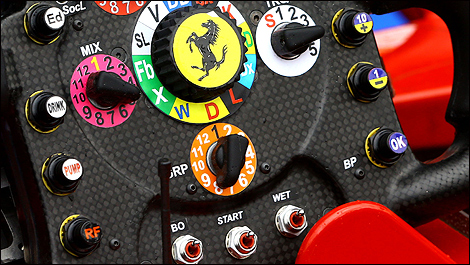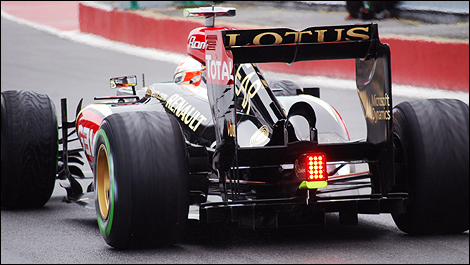Oct
28th
Stay connected Subscribe to our RSS feed
Today we'll put you behind the wheel of a Formula 1 car and explain what needs to be done to start a race.
In an article posted on F1-Monitor, published by High Power Media, our friend Craig Scarborough explains the procedure of starting an F1 car.
Since 2008, fully automatized launch control has been banned. Today, the driver alone must manipulate the throttle and clutch paddles to achieve the best start.
It all begins during the pre-race warm-up lap as the driver executes a certain number of burn-outs. This brings the tires and clutch up to operating temperature, essential for both for the friction qualities of the carbon clutch plates and the thermal expansion of the clutch plates moving the bite point.
Near the end of the parade lap, the driver is asked by the engineers to perform a Bite Point Find (BPF), a process initiated by pressing on a button on the steering wheel. The clutch is released and the electronics detect the drop in engine revs and the clutch position is recorded in the software.
The clutch paddles are then reset to match the bite point position.
The car is steered in neutral to its starting position. Moments before the start, the driver will then pull in both clutch paddles and selects first gear, while holding the revs at around 13,000 rpm.
When the lights are on, both clutch paddles are partially released to a pre-set position, which moves the clutch to the bite point.
To start the car, the driver lets go one clutch paddle, which releases the clutch part way between the bite point and fully released, and can modulate the throttle to manage wheel spin or avoid stalling.
Once the car is moving forward and wheel spin has significantly decreased, the driver releases the second clutch paddle. Now the clutch is fully engaged and the full engine power is passing into the transmission.
In an article posted on F1-Monitor, published by High Power Media, our friend Craig Scarborough explains the procedure of starting an F1 car.
Since 2008, fully automatized launch control has been banned. Today, the driver alone must manipulate the throttle and clutch paddles to achieve the best start.
It all begins during the pre-race warm-up lap as the driver executes a certain number of burn-outs. This brings the tires and clutch up to operating temperature, essential for both for the friction qualities of the carbon clutch plates and the thermal expansion of the clutch plates moving the bite point.
 |
| The "Start" switch and BP (Bite Point) button are clearly visible. (Photo: Ferrari) |
Near the end of the parade lap, the driver is asked by the engineers to perform a Bite Point Find (BPF), a process initiated by pressing on a button on the steering wheel. The clutch is released and the electronics detect the drop in engine revs and the clutch position is recorded in the software.
The clutch paddles are then reset to match the bite point position.
The car is steered in neutral to its starting position. Moments before the start, the driver will then pull in both clutch paddles and selects first gear, while holding the revs at around 13,000 rpm.
When the lights are on, both clutch paddles are partially released to a pre-set position, which moves the clutch to the bite point.
 |
| Romain Grosjean performing a start at the exit of the pit lane in Montreal. (Photo: René Fagnan) |
To start the car, the driver lets go one clutch paddle, which releases the clutch part way between the bite point and fully released, and can modulate the throttle to manage wheel spin or avoid stalling.
Once the car is moving forward and wheel spin has significantly decreased, the driver releases the second clutch paddle. Now the clutch is fully engaged and the full engine power is passing into the transmission.
 The latest auto news, reviews, prices, product and vehicle releases.
The latest auto news, reviews, prices, product and vehicle releases.